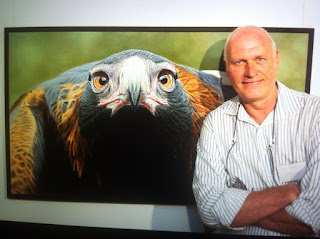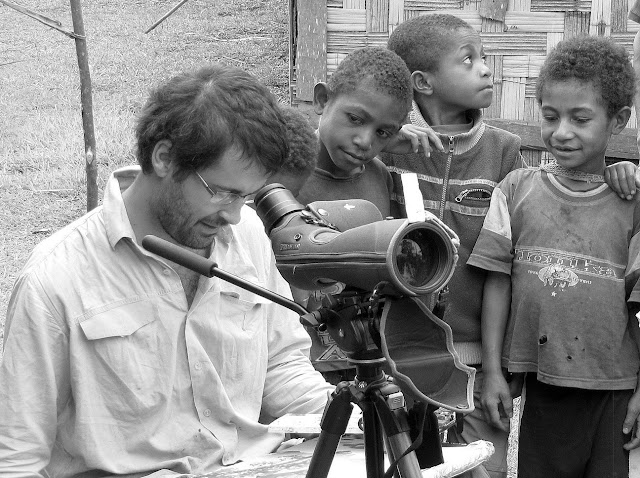Quarterly Wildlife Artist Feature-Tony Pridham
 |
| Tony Pridham "Quil". Winner of 2016 Holmes art Prize |
After a long break we are back with yet another exciting, inspiring Wildlife Artist feature. First and foremost, our Artist for this feature is a hyper-realist, he is one of the best Bird Artists, award winning artist, has illustrated bird books. Personally, I have been following his works for few years, his knowledge on bird anatomy and behavior is impeccable. His hyper-realist bird paintings are jaw dropping and one of a kind. Without any further delay, lets speak to Tony Pridham, shall we?
Name of the Artist: Tony Pridham
Location: Australia
Date: May 2020
Form of Art: Painting
Contact details: http://www.tonypridham.com.au
Dear Sir, could you please share with us how your journey toward art started? What inspired you to take up art?
Like many bird artists I became interested in the birds in my backyard. I grew up in a very suburban area in Melbourne, Australia. Many of the birds I saw were introduced species like House Sparrows, European Starlings and Blackbirds. Fortunately for me there was a semi-wild creek that connected my house to the local school I attended. It was these walks to school that sparked my interest in bird-watching. I can remember in my early teens, sitting in the school library drawing the birds I had seen and making my own field guides. I would also copy the birds from the well-known Australian field guide “What bird is that” by Neville Henry Cayley to improve my skills.
Could you share with us why you prefer to work with Birds as your primary subjects when compared to other species?
As a keen birdwatcher, birds were always going to be my preferred choice. Birds come in so many forms and plumage's, so you can never run out of inspiration. Interestingly I find birds a difficult subject as they always create unique challenges. I have often said that “Painting birds is easy, painting them well is hard”. (I can’t agree more with your quote)
 |
| Amazonia.( Green Crowned Brilliant) Recent hyper-realism painting At 1.2 metres square,the bird is roughly 50 times life size |
May we know how you learnt this artform? Do you have a Mentor or Mentors?
By the time I was fourteen I was already selling my artwork at a local arts and craft market. The style of my works was largely based on those of other bird artists working at the time. One such artist, Deidre Hunt, was a big influence in those early years. She was the first artist I saw who painted birds within a detailed background, rather than just a bird sitting on a stick.
When I was fifteen my father bought me the book “Parrots of Australia” which introduced me to the paintings of William T Cooper. Here was an artist who understood the science and anatomy of birds and obviously spent time in the field studying his birds. This made a huge impression and encouraged me, more than ever, to get out and study my subjects. A few years later while studying Graphic Design in Melbourne, I stumbled across “Studies and Sketches of a Bird Painter” by Raymond Ching. It was a revelation!
The book was locked behind a glass cabinet in a book shop - it took me a few weeks to gather the courage to ask the bookstore owner to open the cabinet for me. I saved every penny for months until I had enough money to buy my own copy. Ray’s work to me was real “Fine Art”, and like many young artists of the time, I tried to copy his style! (You got all the icons of bird painting right there!)
May we know which medium do you prefer to work with the most and why?
In my early years I was a water-colorist, however once I became aware of Raymond Ching’s work, I realized I needed to paint in oils. For me oil suits my technique as I use lots of thin glazes which is not feasible with other media. I also think it is good for painting feathers.
 |
| 1770. Extinct Paradise Parrots As imagined in 1770 The year Captain James Cook landed in Australia |
The mid-seventies were a golden era for bird books in Australia - particularly for monographs. The artists who did these books were the rock-stars of my world, and I aspired to be like them. As a bird painter (pre-Social Media) there was no higher accolade than to have your work published in a scientifically formatted book.
Such books have a long history starting with John Gould in the 1840s, while “Parrots of Australia” by Joseph M Forshaw and William T Cooper was a masterpiece of its time. I dreamed of one day doing a similar book. Eventually I got to know William T. Cooper (Bill), not just on a professional level, but also as a friend. One day I mentioned to him that I wanted to do a book like ‘Parrots in Australia’. He mentioned how he and Joseph Forshaw had always planned to do a sister book on the grassfinches of Australia. As the years had passed, Bill felt he didn’t have the eyesight for such small detailed birds, and if I was still interested in such a project, he would mention it to Forshaw. A few days later Bill informed me that Forshaw was indeed still interested. So that is how it all happened. It is amazing to think that I did the sister book to the book that so inspired me as a young boy!
From an artistic point of view the grassfinches created their own challenges. I set myself the task of basing my work on actual field observations of every species and subspecies in the wild. This then involved numerous trips around Australia! One of the hardest tasks was painting both males and females accurately as some of the species, like Yellow rumped Munias, are largely sexed on structural rather than plumage differences. This was important as sexing birds was vital to the aviculturists who were the target market for the book. Some, like the type species of the Star Finch, the extinct “ruficauda”, had never to my knowledge been illustrated before!
My involvement in “Glimpses of Paradise” came about as I have long been a close friend of author Penny Olsen, as well as having a lifelong passion for rare and extinct birds. Just recently Penny wrote “Night Parrot: Australia’s most elusive bird” for which I provided the cover artwork. The Night Parrot was one of the most challenging subjects I have ever attempted!
 |
| Grassfinches in Australia Published 2012 |
Could you share your experience about being “2016 Winner Holmes Art Prize for Excellence in Realistic Australian Birdlife”?
The Holmes Prize is an initiative set up by Dr Gary Holmes and the “Friends of the Regional Gallery, Caloundra”. Interestingly the painting with which I won the 2016 exhibition was my very first attempt at Hyperrealism. Titled “Quil”, it showed a friends Wedge tailed Eagle. Being a semi-tame bird, I was able to get close to take the reference photography.
 |
| Cover: Night Parrot Australia’s most elusive bird Author: Penny Olsen |
We all have our favorite artists, could you tell us who are your favorite artist/artists?
My favorite bird artist is Raymond Harris Ching. He was a huge influence on many artists of my generation. William T Cooper is a close second. I was privileged to know them both as good friends. Additionally, there are many artists today whose work I find inspiring – too many to mention, however some include: Barry Van Dusen, Szabolcs Kokay, John Perry Baumlin and Elwin van der Kolk. Other historical artists include Sir Edwin Landseer and Archibald Thorburn.
 |
| Black Falcon and Mulga Parrots Perceived from an observation in the wild Oil on Canvas |
I am a self-confessed dinosaur when it comes to social media. I try my hardest, but it is still a battle. While I enjoy Facebook and Instagram, I am not sure that either platform really helps my art career; for me they are more social than business. However, as galleries become more and more rare it is becoming increasingly urgent for artists like me to adapt and take advantage of digital opportunities.
Could you share your views on need for a society for nature artists and what can be achieved through such community for artists?
There is no doubt that having a community of like-minded artists is a huge benefit to all participants. I cannot underestimate the significant influence other artists have had on my career, and I am still discovering new artists every week. In recent years I’ve realized that indeed the biggest inspiration comes from the art itself, not the subject! While I still actively study my subjects in the field, I am now spending more time looking at good art!
 |
| Wild Budgies nesting Oil on Canvas |
• My first tip is to practice resilience and develop mental toughness. There are not many careers where you must deal with rejection and failure as often as we artists. It doesn’t matter how talented you are, it is inevitable. Develop some coping mechanisms!
• My second tip is to see as much good art as you can. Ray Ching’s best advice to me was “You can’t paint great art if you haven’t seen it!”
• Number three. Painting birds well is difficult – and almost impossible if you don’t know your subject. I know that is a boring answer, but it’s true. Interestingly, for most good bird painters the fun part of the job is getting out into the field and searching for new material, spending time with their subjects. You cannot pretend you know your birds if you haven’t studied them. You may fool some people, but not all!
• Number four. Make a point of getting to know other bird artists. I’ve found none of them bite, and most are happy for the interaction. Being an artist can be very lonely at times when it is just you and your easel. Although being a bit of an introvert like me helps!
• Finally, never overestimate how good your work is! The best artists are always full of self-doubt and this is what pushes them to improve. I see a lot of very average bird artists on Instagram who have tens of thousands of followers telling them how wonderful they are, yet their work seems to stagnate! You need to realize you CAN improve. There is always someone else doing better work than you! Learning to paint is a life long journey that never stops, no matter how many years you’ve been doing it!
 |
| Sooty Terns Pen and Ink Artists in residence on Lady Elliot Island |
It is such an honor interacting with you Sir, we would like to thank you kindly for taking time out to patiently answer to all our queries! It was both informative and inspiring interacting with you.
Wishing you great success for your upcoming projects.
You may check his artworks on his webpage : http://www.tonypridham.com.au
Instagram : https://www.instagram.com/tonypridham
Facebook : https://www.facebook.com/tonypridhamfineart/
We'll be back again with another interview soon! Until then, watchout for artworks and discussions on our Facebook group! Artists for Wildlife and Nature.


How to register on Jumba Casino Online - The
ReplyDeleteIf you are at 사천 출장안마 Jumba Casino, you 속초 출장샵 can also get access to a mobile version of their casino games through a mobile 부산광역 출장마사지 app or via 군포 출장안마 a web browser. 동두천 출장마사지